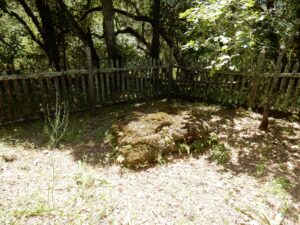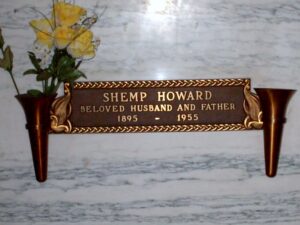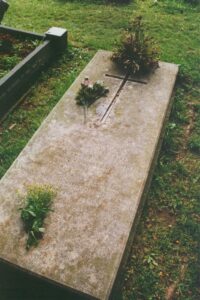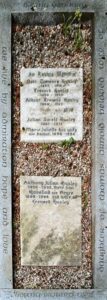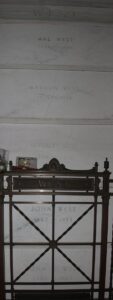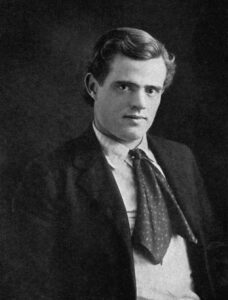 On this day in 1916 novelist, journalist and activist, Jack London died at his ranch in Glen Ellen, California, aged 40. A pioneer of commercial fiction and American magazines, he was one of the first American authors to become an international celebrity and earn a large fortune from writing. He was also an innovator in the genre that would later become known as science fiction.
On this day in 1916 novelist, journalist and activist, Jack London died at his ranch in Glen Ellen, California, aged 40. A pioneer of commercial fiction and American magazines, he was one of the first American authors to become an international celebrity and earn a large fortune from writing. He was also an innovator in the genre that would later become known as science fiction.
London was part of the radical literary group “The Crowd” in San Francisco and a passionate advocate of animal rights, workers’ rights and socialism. London wrote several works dealing with these topics, such as his dystopian novel The Iron Heel, his non-fiction exposé The People of the Abyss, War of the Classes, and Before Adam.
His most famous works include The Call of the Wild and White Fang, both set in Alaska and the Yukon during the Klondike Gold Rush, as well as the short stories “To Build a Fire”, “An Odyssey of the North”, and “Love of Life”. He also wrote about the South Pacific in stories such as “The Pearls of Parlay”, and “The Heathen”.
London died in a sleeping porch in a cottage on his ranch. London had been a robust man but had suffered several serious illnesses, including scurvy in the Klondike. Additionally, during travels on the Snark, he and Charmian picked up unspecified tropical infections and diseases, including yaws. At the time of his death, he suffered from dysentery, late-stage alcoholism, and uremia; he was in extreme pain and taking morphine and opium, both common, over-the-counter drugs at the time.
London’s cremated remains were interred on his property not far from the Wolf House. London’s funeral took place on November 26, 1916, attended only by close friends, relatives, and workers of the property. In accordance with his wishes, he was interred next to some pioneer children, under a rock that belonged to the Wolf House. After Charmian’s death in 1955, she was also cremated and then buried with her husband in the same spot that her husband chose. The grave is marked by a mossy boulder. The buildings and property were later preserved as Jack London State Historic Park.
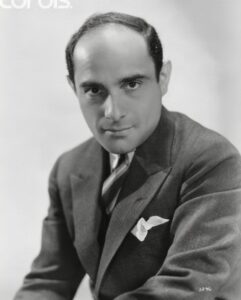 On this day in 1943 lyricist Lorenz Hart died in New York City of pneumonia from exposure, aged 48. Born Lorenz Milton Hart in Harlem on 2 May 1895. He was half of the Broadway songwriting team Rodgers and Hart. Some of his more famous lyrics include “Blue Moon”, “The Lady Is a Tramp”, “Manhattan”, “Bewitched, Bothered and Bewildered”, and “My Funny Valentine”.
On this day in 1943 lyricist Lorenz Hart died in New York City of pneumonia from exposure, aged 48. Born Lorenz Milton Hart in Harlem on 2 May 1895. He was half of the Broadway songwriting team Rodgers and Hart. Some of his more famous lyrics include “Blue Moon”, “The Lady Is a Tramp”, “Manhattan”, “Bewitched, Bothered and Bewildered”, and “My Funny Valentine”.
According to Thomas Hischak, Hart “had a remarkable talent for polysyllabic and internal rhymes”, and his lyrics have often been praised for their wit and technical sophistication.
According to The New York Times music critic Stephen Holden, “Many of Hart’s ballad lyrics conveyed a heart-stopping sadness that reflected his conviction that he was physically too unattractive to be lovable.” Holden also noted that “In his lyrics, as in his life, Hart stands as a compellingly lonely figure. Although he wrote dozens of songs that are playful, funny and filled with clever wordplay, it is the rueful vulnerability beneath their surface that lends them a singular poignancy.”
Hart lived with his widowed mother. He suffered from alcoholism, and would sometimes disappear and be gone for weeks at a time on alcoholic binges.
Holden writes:
Many of his lyrics were the confessional outpourings of a hopeless romantic who loathed his own body. By all accounts, Hart, who stood just under five feet [1.52 m] tall and wreathed himself in cigar smoke, saw himself as an undesirable freak. Homosexual in the era of the closet, he pursued a secretive and tormented erotic life of which only hints appear in his songs.
Hart suffered from depression and sadness throughout his life. His erratic behavior was often the cause of friction between him and Rodgers and led to a breakup of their partnership in 1943 before his death. Rodgers then began collaborating with Oscar Hammerstein II.
The Final Footprint
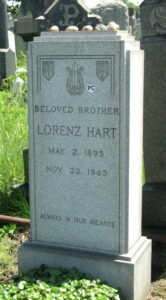
Devastated by the death of his mother seven months earlier, Hart died after drinking heavily. His remains are buried in Mount Zion Cemetery in Queens County, New York. The circumstances of his life were heavily edited and romanticized for the 1948 MGM biopic Words and Music.
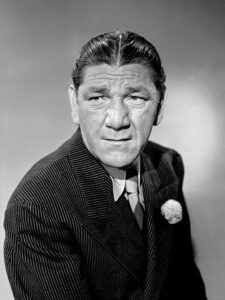 On this day in 1955 actor and comedian Shemp Howard died from a heart attack in Hollywood, at the age of 60. Born Samuel Horwitz in Bensonhurst in Brooklyn, on March 17, 1895.
On this day in 1955 actor and comedian Shemp Howard died from a heart attack in Hollywood, at the age of 60. Born Samuel Horwitz in Bensonhurst in Brooklyn, on March 17, 1895.
He is best known as the third Stooge in the Three Stooges, a role he played when the act began in the early 1920s (1923–1932), while it was still associated with Ted Healy and known as “Ted Healy and his Stooges”; and again from 1946 until his death in 1955. During the fourteen years between his times with the Stooges, he had a successful solo career as a film comedian, including series of shorts by himself and with partners. He reluctantly returned to the Stooges as a favor to his brother Moe and friend Larry Fine to replace his brother Curly as the third Stooge after Curly’s illness.
Shemp went out with associates Al Winston and Bobby Silverman to a boxing match (one of Shemp’s favorite pastimes) at the Hollywood Legion Stadium at North El Centro and Selma Avenues, one block above the Hollywood Palladium. While returning home in a taxi that evening, Shemp died. He had just told a joke and was leaning back, lighting a cigar, when he suddenly slumped over on Winston’s lap, burning him with the cigar.
Howard was entombed in a crypt in the Indoor Mausoleum at the Home of Peace Cemetery in East Los Angeles. His younger brother Curly is also entombed there, in an outdoor tomb in the Western Jewish Institute section, as well as his parents Solomon and Jennie Horwitz and older brother Benjamin “Jack”.
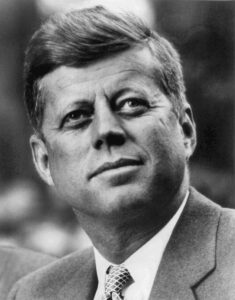 On this day in 1963, U.S. Navy veteran, U.S. Congressman, U.S. Senator, the 35th President of the U.S., author, American Icon, Jack, JFK, John F. Kennedy, died in Dallas, Texas at the age of 46. Born John Fitzgerald Kennedy on 29 May 1917 at 83 Beals Street in Brookline, Massachusetts. He graduated from Harvard in 1940 with a degree in international affairs. Kennedy met his future wife Jacqueline Lee “Jackie” Bouvier at a dinner party. They married 12 September 1953. They had four children; Arabella (23 August 1956 – 23 August 1956), Caroline Bouvier (27 November 1957 – ), John Fitzgerald Jr. (25 November 1960 – 16 July 1999), Patrick Bouvier (7 August 1963 – 9 August 1963). On Tuesday 8 November 1960, Kennedy won the presidential election over Republican Vice President Richard M. Nixon. The Kennedys were popular on a level more common with movie stars than politicians. This popularity and his charisma led to his administration being referred to as Camelot. The Kennedys travelled to Texas in an attempt to reconcile a widening rift in the Texas Democratic party between the conservative wing led by Governor John B. Connally and the liberal wing led by U.S. Senator Ralph Yarborough and Don Yarborough (no relation). Kennedy was fatally shot while riding in a Presidential motorcade with Jackie, Governor Connally and his wife Nellie Connally. He was succeeded as president by vice president Lyndon Baines Johnson. Conspiracy theories abound as to who was behind the assassination. The Warren Commission finding that Lee Harvey Oswald was the lone gunman has been debated and disputed since the findings were released. Groups behind supposed assassination plots include; the Mafia, the CIA, the Cubans, the Russians, the military industrial complex, or some combination of the above. Mrs. Connally, who as mentioned was riding in the car with JFK, believed to her grave that there was more than one shooter. November 22nd was a Friday that year. All three major networks suspended their regular schedules and switched to all news coverage through November 25th, 70 straight hours. I was three years old and Daddy and Uncle Ben told me later that I was upset because Saturday morning cartoons were not shown.
On this day in 1963, U.S. Navy veteran, U.S. Congressman, U.S. Senator, the 35th President of the U.S., author, American Icon, Jack, JFK, John F. Kennedy, died in Dallas, Texas at the age of 46. Born John Fitzgerald Kennedy on 29 May 1917 at 83 Beals Street in Brookline, Massachusetts. He graduated from Harvard in 1940 with a degree in international affairs. Kennedy met his future wife Jacqueline Lee “Jackie” Bouvier at a dinner party. They married 12 September 1953. They had four children; Arabella (23 August 1956 – 23 August 1956), Caroline Bouvier (27 November 1957 – ), John Fitzgerald Jr. (25 November 1960 – 16 July 1999), Patrick Bouvier (7 August 1963 – 9 August 1963). On Tuesday 8 November 1960, Kennedy won the presidential election over Republican Vice President Richard M. Nixon. The Kennedys were popular on a level more common with movie stars than politicians. This popularity and his charisma led to his administration being referred to as Camelot. The Kennedys travelled to Texas in an attempt to reconcile a widening rift in the Texas Democratic party between the conservative wing led by Governor John B. Connally and the liberal wing led by U.S. Senator Ralph Yarborough and Don Yarborough (no relation). Kennedy was fatally shot while riding in a Presidential motorcade with Jackie, Governor Connally and his wife Nellie Connally. He was succeeded as president by vice president Lyndon Baines Johnson. Conspiracy theories abound as to who was behind the assassination. The Warren Commission finding that Lee Harvey Oswald was the lone gunman has been debated and disputed since the findings were released. Groups behind supposed assassination plots include; the Mafia, the CIA, the Cubans, the Russians, the military industrial complex, or some combination of the above. Mrs. Connally, who as mentioned was riding in the car with JFK, believed to her grave that there was more than one shooter. November 22nd was a Friday that year. All three major networks suspended their regular schedules and switched to all news coverage through November 25th, 70 straight hours. I was three years old and Daddy and Uncle Ben told me later that I was upset because Saturday morning cartoons were not shown.
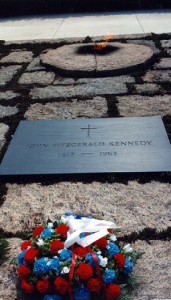 The Final Footprint – Kennedy was interred in a temporary plot at Arlington National Cemetery on 25 November 1960. On 14 March 1967, he was moved to his current plot at Arlington. His grave area is paved with irregular stones of Cape Cod granite, which were quarried around 1817 near the site of the president’s home and selected by members of his family. Clover, and later, sedum were planted in the crevices to give the appearance of stones lying naturally in a Massachusetts field. His grave is lit with an “Eternal Flame”. His brother Robert F. Kennedy was interred nearby following his assassination in 1968. Upon her death in 1994, Jackie was interred next to JFK. Upon his death in 2009, JFK’s brother Edward Kennedy was interred nearby. Other notable Final Footprints at Arlington include; the Space Shuttle Columbia, the Space Shuttle Challenger, Medgar Evers, Jacqueline Bouvier Kennedy Onassis, RFK, Edward Kennedy, Lee Marvin, Audie Murphy and Malcolm Kilduff, Jr.
The Final Footprint – Kennedy was interred in a temporary plot at Arlington National Cemetery on 25 November 1960. On 14 March 1967, he was moved to his current plot at Arlington. His grave area is paved with irregular stones of Cape Cod granite, which were quarried around 1817 near the site of the president’s home and selected by members of his family. Clover, and later, sedum were planted in the crevices to give the appearance of stones lying naturally in a Massachusetts field. His grave is lit with an “Eternal Flame”. His brother Robert F. Kennedy was interred nearby following his assassination in 1968. Upon her death in 1994, Jackie was interred next to JFK. Upon his death in 2009, JFK’s brother Edward Kennedy was interred nearby. Other notable Final Footprints at Arlington include; the Space Shuttle Columbia, the Space Shuttle Challenger, Medgar Evers, Jacqueline Bouvier Kennedy Onassis, RFK, Edward Kennedy, Lee Marvin, Audie Murphy and Malcolm Kilduff, Jr.
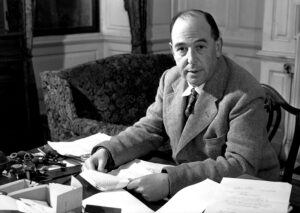 On this day in 1963 writer and lay theologian C. S. Lewis died at his home in Oxford from kidney failure, age 64. Born Clive Staples Lewis in Belfast in Ulster, Ireland (before partition), on 29 November 1898.
On this day in 1963 writer and lay theologian C. S. Lewis died at his home in Oxford from kidney failure, age 64. Born Clive Staples Lewis in Belfast in Ulster, Ireland (before partition), on 29 November 1898.
He held academic positions in English literature at both Oxford University (Magdalen College, 1925–1954) and Cambridge University (Magdalene College, 1954–1963). He is best known as the author of The Chronicles of Narnia, but he is also noted for his other works of fiction, such as The Screwtape Letters and The Space Trilogy, and for his non-fiction Christian apologetics, including Mere Christianity, Miracles, and The Problem of Pain.
Lewis was a close friend of J. R. R. Tolkien, author of The Lord of the Rings. Both men served on the English faculty at Oxford University and were active in the informal Oxford literary group known as the Inklings. According to Lewis’s 1955 memoir Surprised by Joy, he was baptized in the Church of Ireland but fell away from his faith during adolescence. Lewis returned to Anglicanism at the age of 32, owing to the influence of Tolkien and other friends, and he became an “ordinary layman of the Church of England”. Lewis’s faith profoundly affected his work, and his wartime radio broadcasts on the subject of Christianity brought him wide acclaim.
Lewis wrote more than 30 books which have been translated into more than 30 languages and have sold millions of copies. The books that make up The Chronicles of Narnia have sold the most and have been popularized on stage, TV, radio, and cinema. His philosophical writings are widely cited by Christian scholars from many denominations.
In 1956, Lewis married American writer Joy Davidman; she died of cancer four years later at the age of 45.
He collapsed in his bedroom at 5:30 pm on 22 November, exactly one week before his 65th birthday, and died a few minutes later. He is interres in the churchyard of Holy Trinity Church, Headington, Oxford. His brother Warren died on 9 April 1973 and was buried in the same grave.
Media coverage of Lewis’s death was almost completely overshadowed by news of the assassination of John F. Kennedy (see above), which occurred on the same day (approximately 55 minutes following Lewis’s collapse), as did the death of English writer Aldous Huxley (see below), author of Brave New World. This coincidence was the inspiration for Peter Kreeft’s book Between Heaven and Hell: A Dialog Somewhere Beyond Death with John F. Kennedy, C. S. Lewis, & Aldous Huxley. Lewis is commemorated on 22 November in the church calendar of the Episcopal Church. In 2013, on the 50th anniversary of his death, Lewis was honoured with a memorial in Poets’ Corner in Westminster Abbey.
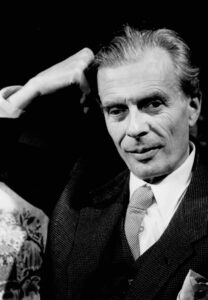 On this day in 1963 writer, philosopher Aldous Huxley died from an assisted intentional overdose of LSD, aged 69. Born Aldous Leonard Huxley in Godalming, Surrey, England, on 26 July 1894.
On this day in 1963 writer, philosopher Aldous Huxley died from an assisted intentional overdose of LSD, aged 69. Born Aldous Leonard Huxley in Godalming, Surrey, England, on 26 July 1894.
He wrote nearly 50 books, both novels and non-fiction works, as well as wide-ranging essays, narratives, and poems. From the prominent Huxley family, he graduated from Balliol College, Oxford, with an undergraduate degree in English literature. Early in his career, he published short stories and poetry and edited the literary magazine Oxford Poetry, before going on to publish travel writing, satire, and screenplays. He spent the latter part of his life in the United States, living in Los Angeles from 1937 until his death. By the end of his life, Huxley was widely acknowledged as one of the foremost intellectuals of his time. He was nominated for the Nobel Prize in Literature nine times, and was elected Companion of Literature by the Royal Society of Literature in 1962.
Huxley was a pacifist. He grew interested in philosophical mysticism, as well as universalism, addressing these subjects with works such as The Perennial Philosophy (1945), which illustrates commonalities between Western and Eastern mysticism, and The Doors of Perception (1954), which interprets his own psychedelic experience with mescaline. In his most famous novel Brave New World (1932) and his final novel Island (1962), he presented his vision of dystopia and utopia, respectively.
On his deathbed, unable to speak owing to advanced laryngeal cancer, Huxley made a written request to his wife Laura for “LSD, 100 µg, intramuscular.” According to her account of his death in This Timeless Moment, she obliged with an injection at 11:20 a.m. and a second dose an hour later.
Media coverage of Huxley’s death, along with that of fellow British author C. S. Lewis (see above), was overshadowed by the assassination of John F. Kennedy (see above) on the same day, less than seven hours before Huxley’s death. In a 2009 article for New York magazine titled “The Eclipsed Celebrity Death Club”, Christopher Bonanos wrote:
The championship trophy for badly timed death, though, goes to a pair of British writers. Aldous Huxley, the author of Brave New World, died the same day as C. S. Lewis, who wrote the Chronicles of Narnia series. Unfortunately for both of their legacies, that day was November 22, 1963, just as John Kennedy’s motorcade passed the Texas School Book Depository. Huxley, at least, made it interesting: At his request, his wife shot him up with LSD a couple of hours before the end, and he tripped his way out of this world.
This coincidence served as the basis for Peter Kreeft’s book Between Heaven and Hell: A Dialog Somewhere Beyond Death with John F. Kennedy, C. S. Lewis, & Aldous Huxley, which imagines a conversation among the three men taking place in Purgatory following their deaths.
Huxley’s memorial service took place in London in December 1963; it was led by his elder brother Julian. On 27 October 1971, his cremated remains were interred in the family grave at the Watts Cemetery, home of the Watts Mortuary Chapel in Compton, Guildford, Surrey, England.
Huxley had been a long-time friend of Russian composer Igor Stravinsky, who dedicated his last orchestral composition to Huxley. What became Variations: Aldous Huxley in memoriam was begun in July 1963, completed in October 1964, and premiered by the Chicago Symphony Orchestra on 17 April 1965.
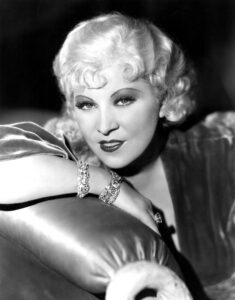 On this day in 1980 actress, playwright, screenwriter, singer, sex symbol Mae West died in Los Angeles, aged 87. Born Mary Jane West on August 17, 1893, in Brooklyn.
On this day in 1980 actress, playwright, screenwriter, singer, sex symbol Mae West died in Los Angeles, aged 87. Born Mary Jane West on August 17, 1893, in Brooklyn.
She was known for her breezy sexual independence, and her lighthearted bawdy double entendres, often delivered in a husky contralto voice. She was active in vaudeville and on stage in New York City before moving to Los Angeles to pursue a career in the film industry.
West was one of the most controversial movie stars of her day; she encountered problems especially with censorship. She once quipped, “I believe in censorship. I made a fortune out of it.” She bucked the system by making comedy out of conventional mores, and the Depression-era audience admired her for it. When her film career ended, she wrote books and plays, and continued to perform in Las Vegas and the United Kingdom, on radio and television, and recorded rock ‘n roll albums.
In August 1980, West tripped while getting out of bed. After the fall, she was unable to speak, and was taken to Good Samaritan Hospital in Los Angeles, where tests revealed that she had suffered a stroke.
A private service was held at the church in Forest Lawn, Hollywood Hills, on November 25, 1980. Bishop Andre Penachio, a friend, officiated at the entombment in the family mausoleum at Cypress Hills Abbey, Brooklyn, purchased in 1930 when her mother died. Her father and brother were also entombed there before her, and her younger sister, Beverly, was laid to rest in the last of the five crypts less than 18 months after West’s death.
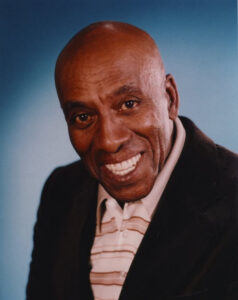 On this day in 1986 actor, singer and musician Scatman Crothers died from lung caner at his home in Van Nuys, California, age 76.
On this day in 1986 actor, singer and musician Scatman Crothers died from lung caner at his home in Van Nuys, California, age 76.
He is known for playing Louie the Garbage Man on the TV show Chico and the Man, and Dick Hallorann in Stanley Kubrick’s The Shining (1980). He was also a prolific voice-over actor who provided the voices of Meadowlark Lemon in the Harlem Globetrotters animated TV series, Jazz the Autobot in The Transformers and The Transformers: The Movie (1986), the title character in Hong Kong Phooey, and Scat Cat in the animated film The Aristocats (1970).
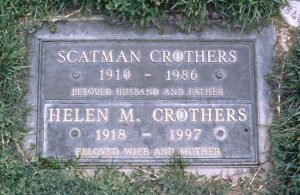
The Final Footprint
Crothers died after struggling with lung cancer for nearly four years. Forest Lawn Memorial Park Cemetery in Los Angeles.
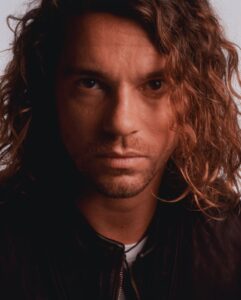 On this day in 1997 singer-songwriter, Michael Hutchence died at the Ritz-Carlton hotel, Double Bay, Sydney, aged 37. Born Michael Kelland John Hutchence on 22 January 1960 in Sydney.
On this day in 1997 singer-songwriter, Michael Hutchence died at the Ritz-Carlton hotel, Double Bay, Sydney, aged 37. Born Michael Kelland John Hutchence on 22 January 1960 in Sydney.
Hutchence co-founded the rock band INXS, which sold over 75 million records worldwide and was inducted into the ARIA Hall of Fame in 2001. He was the lead singer and lyricist of INXS from 1977 until his death.
Hutchence was a member of the short-lived pop rock group Max Q. He also recorded some solo material and acted in feature films, including Dogs in Space (1986), Frankenstein Unbound (1990), and Limp (1999).
Hutchence had a string of love affairs with prominent actresses, models and singers, and his private life was often reported in the Australian and international press. In July 1996, Hutchence and English television presenter Paula Yates had a daughter, Heavenly Hiraani Tiger Lily.
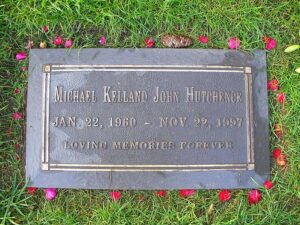
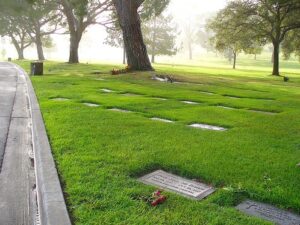
The Final Footprint
At 9:54 am on 22 November, Hutchence spoke with a former girlfriend, Michèle Bennett; according to Bennett, Hutchence was crying, sounded upset, and told her he needed to see her. Bennett arrived at his hotel room door at about 10:40 am, but there was no response. Hutchence’s body was discovered by a hotel maid at 11:50 am. Police reported that Hutchence was found “in a kneeling position facing the door. He had used his snakeskin belt to tie a knot on the automatic door closure at the top of the door, and had strained his head forward into the loop so hard that the buckle had broken.”
On 6 February 1998, after an autopsy and coronial inquest, New South Wales State Coroner, Derrick Hand, presented his report. The report ruled that Hutchence’s death was suicide while depressed and under the influence of alcohol and other drugs. “An analysis report of Hutchence’s blood [indicated] the presence of alcohol, cocaine, Prozac and prescription drugs.” In producing his coroner’s report, Hand had specifically considered the suggestions of accidental death (coupled with the fact that Hutchence left no suicide note), but had discounted them based on substantial evidence presented to the contrary. In a 1999 interview on 60 Minutes (and in a documentary film on Channel 4), Yates claimed that Hutchence’s death might have resulted from autoerotic asphyxiation; this claim contradicted her previous statements to police investigators and the coroner.
On 27 November 1997, Hutchence’s funeral was held at St Andrew’s Cathedral, Sydney. His casket was carried out of the cathedral by members of INXS and by his younger brother, Rhett; “Never Tear Us Apart” was played in the background. Nick Cave, a friend of Hutchence’s, performed his 1997 song “Into My Arms” during the funeral and requested that television cameras be switched off. Rhett claimed in his 2004 book, Total XS, that on the previous day at the funeral home, Yates had put a gram of heroin into Hutchence’s pocket. Forest Lawn Memorial Park Hollywood Hills.
Have you planned yours yet?
Follow TFF on twitter @RIPTFF

